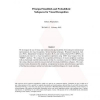Free Online Productivity Tools
i2Speak
i2Symbol
i2OCR
iTex2Img
iWeb2Print
iWeb2Shot
i2Type
iPdf2Split
iPdf2Merge
i2Bopomofo
i2Arabic
i2Style
i2Image
i2PDF
iLatex2Rtf
Sci2ools
PAMI
2002
2002
Principal Manifolds and Probabilistic Subspaces for Visual Recognition
We investigate the use of linear and nonlinear principal manifolds for learning low-dimensional representations for visual recognition. Several leading techniques: Principal Component Analysis (PCA), Independent Component Analysis (ICA), and nonlinear Kernel PCA (KPCA) are examined and tested in a visual recognition experiment using 1800+ facial images from the "FERET" database. We compare the recognition performance of nearest-neighbour matching with each principal manifold representation to that of a maximum a posteriori (MAP) matching rule using a Bayesian similarity measure derived from dual probabilistic subspaces. The experimental results demonstrate the simplicity, computational economy and performance superiority of the Bayesian subspace method over principal manifold techniques for visual matching. This work may not be copied or reproduced in whole or in part for any commercial purpose. Permission to copy in whole or in part without payment of fee is granted for non...
Related Content
| Added | 23 Dec 2010 |
| Updated | 23 Dec 2010 |
| Type | Journal |
| Year | 2002 |
| Where | PAMI |
| Authors | Baback Moghaddam |
Comments (0)

